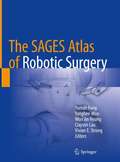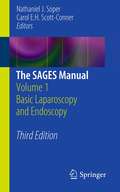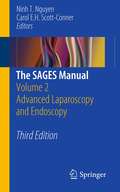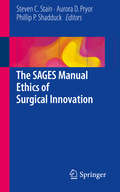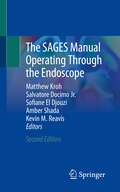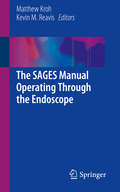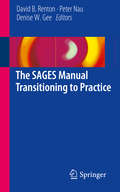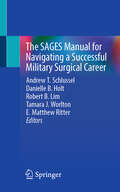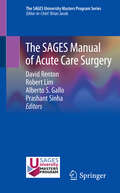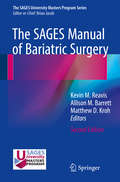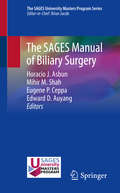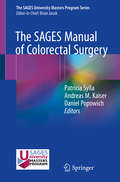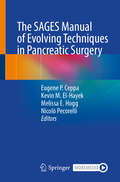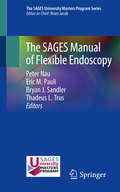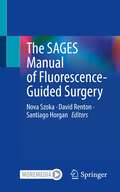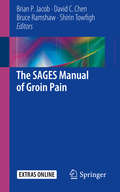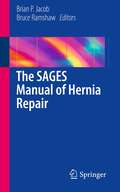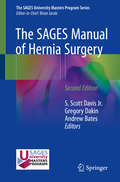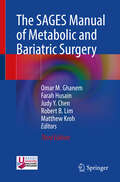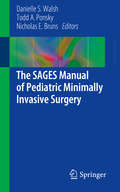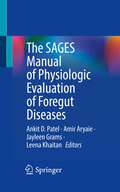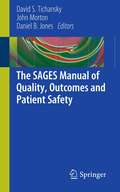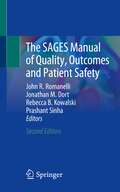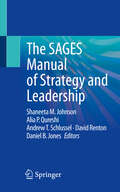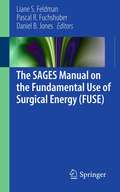- Table View
- List View
The SAGES Atlas of Robotic Surgery
by Vivian E. Strong Yuman Fong Yanghee Woo Woo Jin Hyung Clayton LauThis book is intended as a definitive, state of the art guide to robotic surgery that summarizes the field for surgeons at all levels. More specifically, its goals are threefold: to review the basics of robotic surgery, including fundamental principles, technology, operating room setup, and workflow; to describe and illustrate the procedures most commonly performed in a robotic operating room; and to discuss key issues relating to cost, adoption, and training. Procedures from many surgical disciplines are included, which will aid robotic surgeons in supervising and assisting colleagues in these disciplines and simultaneously heighten their awareness of the tricks and tools used in other disciplines that can be retasked for their own purposes. In addition, the future prospects for robotic surgery, including anticipated developments in equipment, are discussed. The Textbook and Atlas of Robotic Surgery will be an excellent aid for residents and fellows entering the field, as well as a welcome update on recent progress for practicing robotic surgeons and an ideal primer for senior surgeons adapting these new technologies to their current practice.
The SAGES Manual
by Carol E.H. Scott-Conner Nathaniel J. SoperThe much-anticipated revision of the second edition of The SAGES Manual: Fundamentals of Laparoscopy, Thoracoscopy, and GI Endoscopy, has been completely restructured, reorganized, and revised. The Manual has been split into two volumes for better portability. Volume I, Basic Laparoscopy and Endoscopy covers the fundamentals and procedures performed during surgical residency. Volume I will be the first volume used by students, residents, and allied healthcare professional trainees. Material has been added to these fundamentals and procedures that will also be of interest to experienced surgeons. Volume II, Advanced Laparoscopy and Endoscopy covers more advanced procedures, generally taught during fellowship. All of the sections have been reorganized with a critical eye to the needs of the modern minimal access surgeon. Two new editors have been added. Chapters have been revised by both new authors as well as many stalwart authors from previous editions. These portable handbooks cover all of the major laparoscopic and flexible endoscopic procedures in easy-to-read format. Indications, patient preparation, operative techniques, and strategies for avoiding and managing complications are included for the complete spectrum of both "gold standard" and emerging procedures in diagnostic and therapeutic laparoscopy, thoracoscopy, and endoscopy. The scope, detail, and quality of the contributions confirm and demonstrate the SAGES commitment to surgical education. This manual is sure to find a home in the pocket, locker or briefcase of all gastrointestinal endoscopic surgeons and residents.
The SAGES Manual
by Carol E.H. Scott-Conner Ninh T. NguyenThe much-anticipated revision of the second edition of The SAGES Manual: Fundamentals of Laparoscopy, Thoracoscopy, and GI Endoscopy, has been completely restructured, reorganized, and revised. The Manual has been split into two volumes for better portability. Volume I, Basic Laparoscopy and Endoscopy covers the fundamentals and procedures performed during surgical residency. Volume I will be the first volume used by students, residents, and allied healthcare professional trainees. Material has been added to these fundamentals and procedures that will also be of interest to experienced surgeons. Volume II, Advanced Laparoscopy and Endoscopy covers more advanced procedures, generally taught during fellowship. All of the sections have been reorganized with a critical eye to the needs of the modern minimal access surgeon. Two new editors have been added. Chapters have been revised by both new authors as well as many stalwart authors from previous editions. These portable handbooks cover all of the major laparoscopic and flexible endoscopic procedures in easy-to-read format. Indications, patient preparation, operative techniques, and strategies for avoiding and managing complications are included for the complete spectrum of both "gold standard" and emerging procedures in diagnostic and therapeutic laparoscopy, thoracoscopy, and endoscopy. The scope, detail, and quality of the contributions confirm and demonstrate the SAGES commitment to surgical education. This manual is sure to find a home in the pocket, locker or briefcase of all gastrointestinal endoscopic surgeons and residents.
The SAGES Manual Ethics of Surgical Innovation
by Aurora D. Pryor Steven C. Stain Phillip P. ShadduckThis text provides a comprehensive review of the ethical issues involved with the development, evaluation, and introduction of new treatments of gastrointestinal diseases. How several landmark surgical innovations were developed are described to show the challenges faced, and the ethical dilemmas these innovators dealt with. The challenges of dealing with regulatory issues, and how to work with industry partners, and investors when working on a new therapy is described. Once a new technology has been brought to the market, standards need to be developed regarding the training, credentialing and adoption of the new technology. There are insufficient standards of how to balance the desire to provide patients the latest therapy with the obligation that patients receive informed consent about the new technology, and the relationship that the physician may have had with product development. The book describes the national perspective of paying for new technology, and provides one insurance company's approach to the introduction of innovative therapy. The Sages Manual Ethics of Surgical Innovation will be a resource for surgeons, researchers and health policy personnel to understand the ethical issues related to the development, introduction and adoption of innovative therapies for gastrointestinal diseases. Although the context for discussion is the application of innovation to gastrointestinal disease, the ethical issues are applicable to any discussion of innovative medical or procedural therapies.
The SAGES Manual Operating Through the Endoscope
by Matthew Kroh Kevin M. Reavis Salvatore Docimo Jr. Sofiane El Djouzi Amber ShadaIn 2016 the first edition of the SAGES Manual Operating through the Endoscope was published. At the time, this represented a review of cutting-edge new technologies that were being introduced within the field of flexible endoscopy. Largely based on applications and data up to 2013, this served as a unique resource for clinicians and researchers to learn about this expanding field. Since then, there has been a significant expansion of new technologies and procedures within this discipline that have meaningfully changed this entire sub-specialty. In addition, large numbers of high-quality data have emerged that support more heartily the safety and efficacy of these techniques. Major international societies now routinely include hands-on training and scientific content of this field in meetings and educational efforts, and many trainees and practitioners are looking for resources to improve their knowledge and technical skills sets. For these reasons, an update on this rapidly advancing field seems appropriate at this time, given the enormous amount of new content available. Endoscopic surgical procedures allow for less invasive access for performing increasingly complex procedures. This results in maximal benefit for patients with fewer complications, faster recovery, and less pain. Endoscopy allows access to the gastrointestinal tract without transgressing the abdominal or chest walls, by means of a truly less invasive route. These technologies and skills are being sought out by practitioners and asked for by patients.The proposed textbook is designed to present a comprehensive and state-of the-art approach to the diverse applications of surgical techniques and procedures through the endoscopic platform. Written by experts and emerging specialists in that field, each of these sections will address patient selection, pre-operative considerations, technical conduct of the most common operations, and avoiding complications. A review of the existing literature addressing the particular topic will follow in each section. Extensive endoscopic images and illustrations will make this an interactive text. In addition to updates on most topics in the previous manual, this edition will include exciting new fields of advanced imaging, artificial intelligence and augmented imaging, applications of robotics to endoscopy, and more robust exposure of endoscopic applications for treatment of obesity, a worldwide epidemic.The subject of surgical endoscopy has changed meaningfully since publication of the first edition; now a substantial focus of major journals, scientific meetings, and online platforms. A timely update can capture this broad subject in an accessible manual focused on technologies and data supporting these interventions.
The SAGES Manual Operating Through the Endoscope
by Matthew Kroh Kevin M. ReavisThis manual presents a comprehensive and state of the-art approach to the diverse applications of surgical techniques and procedures through the endoscopic platform. Sections address preliminary issues faced by surgeons and physicians who may be initially undertaking these new techniques. These areas include training and credentialing, as well as tools and platforms commonly used for these procedures. Subsequent chapters focus on specific disease processes and the endoscopic applications for those procedures. Each section addresses patient selection, pre-operative considerations, technical conduct of the most common operations, and avoiding complications. A brief review of the existing literature addressing the particular topic follows in each section. The text concludes with chapters on future directions and device development. Written by experts in the field, The SAGES Manual Operating Through the Endoscope is a valuable resource to experienced advanced endoscopists looking to expand the types of procedures that they currently perform, as well as trainees, including residents, fellows and medical students.
The SAGES Manual Transitioning to Practice
by David B. Renton Peter Nau Denise W. GeeThis SAGES manual will help educate and advise our new and recent surgical graduates on entering the job market. From how to find a job, to contract negotiations, to research and grant proposals, this manual offers pertinent strategies crucial to both surgical and non-surgical subspecialty fields. Chapters focusing on work-life balance and finding a mentor offer helpful insight to prevent burnout and optimize one's new career. The SAGES Manual: Transitioning to Practice will fill the gap in resident education and prove a useful text for residents, fellows and recent graduates as well as practicing surgeons in all subspecialties of surgery.
The SAGES Manual for Navigating a Successful Military Surgical Career
by Robert B. Lim Andrew T. Schlussel Danielle B. Holt Tamara J. Worlton E. Matthew RitterThe aim of this manual is to offer a comprehensive framework for both present and future military surgeons, enabling them to effectively navigate and build a successful career within the military, while also providing them with transferable skills upon completion of their military service. The military healthcare system operates within a unique framework with distinct challenges and opportunities. By acquiring knowledge and insights into the intricacies of military career paths, surgeons can make informed decisions about assignments, promotions and professional development. Navigating an Army, Air Force, Navy or Reserve career requires an understanding of the organizational structures, consultant roles and specific requirements of each service branch. Additionally, being aware of opportunities for advanced education, leadership development and operational assignments enables surgeons to develop a career trajectory aligned with their goals and aspirations. Presently there is not a sole source document, either in the military or civilian sectors, that allows easy access and references to the multiple opportunities afforded to military surgeons or an understanding of life as a surgeon on active duty. Furthermore, this text provides context to civilian organizations, administrative personnel, recruiting departments and family members that interact with or assist in making important decisions for military surgeons. This manual features insight and guidance from senior leaders of our Armed Forces, both past and present, who have excelled in academic, operational and clinical surgical careers. By providing a reference for successfully navigating a military career, this will not only enhance the professional growth of a surgeon, but also ensure the delivery of high-quality healthcare to our service members and beneficiaries both domestic and abroad.
The SAGES Manual of Acute Care Surgery
by David Renton Robert Lim Alberto S. Gallo Prashant SinhaThis book provides a concise summation of current operative decision making and techniques for situations faced by the on-call general surgeon. This manual covers pertinent topics such as minimally invasive surgery in the trauma setting, surgical emergencies in the bariatric patient, and treatment of emergencies in pregnancy, cirrhotics, and anti-coagulated patients. The experts at SAGES pooled their knowledge and created this manual to describe the most up-to-date treatment options for the emergent surgical patient. The SAGES Manual of Acute Care Surgery aligns with the new SAGES UNIVERSITY MASTERS Program and supplements the Master’s Program Acute Care Pathway. Its goal is to help educate surgeons to bring the optimum care to the patients that they are called to see in their emergency rooms, and to help surgeons progress from the competent to the proficient and finally to the mastery level.
The SAGES Manual of Bariatric Surgery
by Kevin M. Reavis Allison M. Barrett Matthew D. KrohMorbid obesity is an epidemic as more than 2/3 of the United States population is obese and as such, has a high burden of weight-related co-morbid diseases. Bariatric surgery has proven to be effective and durable for treatment of severe obesity. Technological advances including applications of laparoscopy and endolumenal techniques have rapidly advanced this field. Data and outcomes examining treatments have also improved and as providers, we have a wide spectrum of therapeutic options to treat patients.As techniques and outcomes have evolved, access to a comprehensive yet focused resource regarding bariatric surgery is currently limited. The proposed textbook is designed to present a comprehensive and state-of the-art approach to the current and future status of Bariatric interventions, which has changed significantly since the first edition of the Manual. Updates in this version will include the rapidly expanding field of endoluminal bariatric procedures, with a focus on new devices and theories of mechanisms. New data regarding laparoscopic approaches to treat obesity, as well as improved longer-term data outcomes will be reviewed. Newer surgical approaches to treat metabolic disease and obesity are included, as well as proposed mechanisms of action and efficacy. Additional new sections include sections on the application of robotic technologies, special circumstances including transplantation and pregnancy, and telemedicine and social media in bariatric surgery.Sections will address the evolution in specific treatments available to patients, initial evaluation and selection of procedures for individual patients, the latest surgical and endoscopic techniques being employed to treat patients including data on outcomes, and future directions for therapy. In particular and unique amongst references, a major focus of this text will be on both the bariatric and metabolic bases of therapies and outcomes.The SAGES Manual A Practical Guide to Bariatric Surgery, Second Edition aligns with the new SAGES UNIVERSITY MASTERS Program. The Manual supplements the Bariatric Surgery Pathway from Competency to Proficiency to Mastery. Whether it’s for Biliary, Hernia, Colon, Foregut or Bariatric, the key technical steps for the anchoring bariatric procedures are highlighted in detail as well as what the reader needs to know to successfully submit a video clip to the SAGES Facebook Channels for technical feedback. Readers will also learn about how to count credits for Bariatric from the other Master Program Series, Guidelines, Top 21 Videos, Pearls, FLS, FES, FUSE, SMART and Annual SAGES Meeting. The Masters Program promotes lifelong deliberate learning.
The SAGES Manual of Biliary Surgery
by Horacio J. Asbun Mihir M. Shah Eugene P. Ceppa Edward D. AuyangAlthough benign biliary disease is an area in which many surgeons have experience, there are many nuances to providing the highest quality of surgical care. The biliary anatomy is unique but presents with anatomical variances and can be distorted by benign pathology. Biliary surgery has been one of the areas where minimally invasive techniques were first applied in the late 1980s. However, surgical technique has continued to evolve due to acquisition of advanced minimal surgical skills and improvement in surgical technology. The expertise, sage, and knowledge of the members of the Society of American Gastrointestinal and Endoscopic Surgery (SAGES) have prioritized the creation of this manual on modern biliary surgery.This manual will provide the standard for the current state of biliary surgery in the 21st century. The SAGES Manual of Biliary Surgery will align with the new SAGES University Masters program. The Manual supplements the Masters Program Biliary Surgery Pathway. Its goal is to help the surgeon progress from the competent to the proficient and finally to the mastery level. Both for the surgical trainee and senior surgeon, this guidebook will also give insight into modern evaluation and management. The highlights will emphasize what is both feasible and safe from a minimally invasive approach in biliary surgery. The concept of Safe Cholecystectomy will be defined and expounded on in detail. The difficult cholecystectomy will be given ample coverage to include management of intraoperative bile duct injury, indications and techniques of subtotal cholecystectomy, and special attention to intraoperative diagnostic imaging that serve as adjuncts, including cholangiograpy, ultrasound, as well as indocyanine green biliary fluorescence. We will review the updated international Tokyo guidelines for acute cholecystitis. Furthermore, the evolution of treatment of choledocohlithiasis has evolved the most in recent years, and thus requires an extensive discussion of the non-operative and operative management of bile duct stones.This text will serve as an important contribution to the medical literature sponsored by SAGES, an international leading authority in gastrointestinal surgery with a keen interest in safe and proficient biliary surgery. Leaders in the field of biliary surgery will impart their insight and considerable experience in the chapters planned for this manual. The intent for this manual is to be the cited resource for high quality and applicable knowledge for the treatment of benign biliary disease.
The SAGES Manual of Colorectal Surgery
by Patricia Sylla Andreas M. Kaiser Daniel PopowichThis book provides essential didactic content for the SAGES University Masters Program Colorectal Surgery Curriculum. Surgeons seeking to complete the competency, proficiency, or mastery curriculum of the MASTERS Colorectal Pathway for a particular anchoring colorectal procedure will find relevant educational content in this SAGES Manual. Written by experts in the field, each chapter provides detailed guidance on preoperative and peri-procedural considerations for right and left elective and emergency colorectal resections, for both benign and malignant pathologies. Technical pearls and strategies to manage pitfalls and complications are also extensively reviewed along with detailed guidance for both laparoscopic and robotic procedures. The SAGES Manual of Colorectal Surgery provides a wealth of practical guidance to surgeons along their journey to progress from competency to mastery in various minimally invasive approaches to colorectal surgery.
The SAGES Manual of Evolving Techniques in Pancreatic Surgery
by Eugene P. Ceppa Kevin M. El-Hayek Melissa E. Hogg Nicolò PecorelliManagement of diseases of the pancreas is varied and complex, and the diagnoses leading to surgical consideration dictate what technical approaches are feasible and safe. Over the last decade, this has changed considerably, and as a result, the necessity of documenting the updated surgical approaches is not only warranted yet paramount to surgeons. This manual presents a contemporary description of pancreatic surgery. The classic open approach maintains relevancy, yet refinement in technique has improved outcomes. The application of laparoscopic techniques provides improvement in recovery when applied appropriately, yet further technological innovations continue to improve this approach. Further innovation and research in robotic, percutaneous and endoscopic techniques have broadened the horizon of the management of pancreatic disease. Chapters in this manual address surgical therapy of benign and malignant disease of the pancreas, including management of acute and chronic pancreatitis as well as benign, premalignant and malignant pancreatic neoplasms, and will focus on specific disease processes and the various approaches that are currently applied. Each of the chapters addresses patient selection, pre-operative considerations, technical conduct of the procedures and minimizing morbidity. A brief review of the existing literature addressing the particular topic is included in each chapter, with extensive illustrations and selected video clips.
The SAGES Manual of Flexible Endoscopy
by Peter Nau Eric M. Pauli Bryan J. Sandler Thadeus L. TrusThis book addresses all aspects of endoscopy from scope and tower basics to the more advanced interventional procedures like endoscopic retrograde cholangiopancreatography, per-oral esophageal myotomy, and percutaneous endoscopic gastrostomy. It covers a broad range of topics in order to remain relevant to the surgical subspecialist, the community general surgeon, the surgical fellow interested in endolumenal and transluminal procedures, and the surgical resident interested in the very basics of endoscopy. The table of contents is intentionally designed to mirror the Flexible Endoscopy curriculum currently being implemented for all minimally invasive, advanced GI and surgical endoscopy fellowships. The chapters are broken up into five parts. The first part introduces the SAGES Masters Program, followed by parts that cover flexible endoscopy basics, flexible endoscopy procedures, and finally bariatric flexible endoscopy. Written by experts and thought leaders in their fields, The SAGES Manual of Flexible Endoscopy serves as a valuable resource for surgeons of all training and skill levels to better grasp an overview of modern endoscopy practice.
The SAGES Manual of Fluorescence-Guided Surgery
by David Renton Santiago Horgan Nova SzokaFluorescence-guided surgery (FGS) is defined as a medical imaging technique that uses a fluorescent dye or a near-infrared emitting light source to identify anatomic structures during surgical procedures. In 2020 alone, over 1200 academic articles were published on the topic of fluorescence-guidance surgery, a sign that this modality is making significant inroads into surgical practice. The use of near-infrared imaging and FGS is a rapidly growing modality, allowing surgeons to see more intraoperatively, enhance surgical precision, and improve surgical decision-making and patient outcomes. This manual provides a comprehensive, state-of-the art review of this field and will serve as a valuable resource for clinicians, surgeons and researchers with an interest in fluorescence-guided surgery, guiding patient management and stimulating investigative efforts. After initial chapters discussing the history of FGS and the current platforms and devices, it presents the most up-to-date data regarding the use of FGS in multiple surgical fields - colorectal, hepatic, endocrine, reconstructive, pediatric, among others - as well as in the treatment of specific conditions such as burns. Chapters are generously illustrated with full-color figures and intraoperative photographs, and selected chapters include video segments. Access to a comprehensive resource such as this is currently limited by the relatively new inroads that fluorescence-guided technology has made into surgery. The SAGES Manual of Fluorescence-Guided Surgery fills this gap in the literature.
The SAGES Manual of Groin Pain
by Brian P. Jacob Bruce Ramshaw David C. Chen Shirin TowfighThis manual captures and summarizes the key elements in management of groin pain, including relevant anatomy, etiologies, diagnostic evaluation tools, imaging, detailed pharmacologic options, interventional modalities and options for operative remediation. The manual separately addresses the management of intrinsic groin pain due to primary disease processes and secondary groin pain due to a prior operation. Current practices, trends in the field, treatment approaches and controversies are addressed. While the primary audience of this book will be general surgeons performing hernia operations and pain management specialists to whom they refer, the SAGES Manual of Groin Pain will serve as a stand alone state-of-the-art resource for all providers who deal with this diagnosis, including primary care providers, sports medicine specialists, gynecologists, urologists, orthopedists, neurologists, physical medicine and rehabilitation specialists, radiologists, physical therapists, industry personnel and importantly, patients who suffer from groin pain who have copious access to health information, but without the filtering, expertise and context provided by the contributors to this manual. This volume also uniquely provides its audience with narrative first-person accounts of some of the most common and challenging causes of pain, so that others can learn from their presentation, pitfalls, successes and failures. The expertise compiled in this manual will give the readership a pragmatic foundation to optimize the diagnosis and management of our patients with this challenging problem.
The SAGES Manual of Hernia Repair
by Brian P. Jacob Bruce RamshawThe SAGES Manual of Hernia Repair will serve as a state-of-the-art resource for hernia surgeons and residents alike who are interested in the rapidly evolving area of abdominal wall hernia repair. This manual captures and summarizes the current trends in the field, as well as describing the new ideas, programs, and strategies regarding hernia repair. Through a unique section called Current Debates in Inguinal Hernia Repair, this volume also provides readers an overview of the current opinions on many of the ongoing debates of this time period. Furthermore, the manual is lavishly illustrated, containing an array of instructional charts and photographs, and is authored by a panel of experts in hernia repair. Comprehensive and easily accessible, The SAGES Manual of Hernia Repair is a portable reference that will be of great value to all practicing surgeons and residents working in the field of abdominal wall hernia repair.
The SAGES Manual of Hernia Surgery
by S. Scott Davis Jr. Gregory Dakin Andrew BatesThis edition of the SAGES Manual of Hernia Surgery aligns with the current version of the new SAGES University MASTERS Program Hernia Surgery pathway. This manual serves as a curriculum for participants in the MASTERS Program as well as a modern text on hernia surgery for all learners. Hernia surgery is one of the fastest developing fields in general surgery today. There have been rapid advancements in hernia techniques in recent years, making most prior texts on the subject obsolete. These advancements involve significant evolution in both the techniques and strategies for hernia repairs, as well as the tools used to achieve these means. This text thoroughly addresses the multiple component separation techniques and options for locations of mesh repairs. It also discusses the revolution of hernia repair being facilitated by robotic surgery, which allows increased access to minimally invasive techniques for surgeons and thus increased access to minimally invasive surgical repairs for patients. This manual will be a valuable resource for interested surgeons to understand the variety of potential approaches to individual hernias, and to individually tailor the care of the hernia patient.
The SAGES Manual of Metabolic and Bariatric Surgery
by Matthew Kroh Robert B. Lim Omar M. Ghanem Farah Husain Judy Y. ChenObesity is an epidemic - more than 40% of the United States population suffers from obesity and, as such, it has a high burden of weight-related conditions and diseases. Metabolic and bariatric surgery has proven to be the most effective and durable treatment of severe obesity. Technological advances including applications of laparoscopy, robotics and endoluminal techniques have rapidly advanced this field. Data and outcomes examining treatments have also improved and, as providers, we have a wide spectrum of therapeutic options to treat patients. As techniques and outcomes change rapidly, access to a comprehensive yet focused resource regarding bariatric surgery is currently limited. The third edition of this manual is designed to present a comprehensive and state-of the-art approach to the current and future status of metabolic and bariatric surgery. Sections will address the evolution in specific treatments available to patients, initial evaluation, and selection of procedures for individual patients, the latest surgical and endoscopic techniques being employed to treat patients including data on outcomes, and future directions for therapy. In particular and unique amongst references, a major focus of this text will be on both the bariatric and metabolic bases of therapies and outcomes.
The SAGES Manual of Pediatric Minimally Invasive Surgery
by Danielle S. Walsh Todd A. Ponsky Nicholas E. BrunsThis manual provides a comprehensive, state-of-the art review of this field, and will serve as a valuable resource for adult and pediatric surgeons at all stages of experience with interest in the use of minimally invasive surgical techniques in children. This book will review the pediatric surgical disorders that are currently treatable with these techniques. After a basic summary of the disorder, the preoperative evaluation and preparation is presented. Each chapter focuses on a detailed discussion of the surgical procedure, inclusive of anesthesia, positioning, instrumentation, and materials. Emphasis is placed on technique and tips for particularly challenging aspects of the operation. A description of the expected postoperative course and common complications of each procedure follows. The outcomes literature to include any advances since the original outcomes and expected future advances for the diagnosis and procedure is presented. It provides a concise yet comprehensive summary of the current status of the field that will help guide patient management and stimulate investigative efforts. All chapters are written by experts in their fields and include the most up to date scientific and clinical information.
The SAGES Manual of Physiologic Evaluation of Foregut Diseases
by Ankit D. Patel Jayleen Grams Amir Aryaie Leena KhaitanEsophageal and gastric pathology are challenging, and the underlying physiology is complex. Advanced diagnostic testing is extensive, and the results can often be difficult to interpret. The impact of these findings on tailored treatment modalities has evolved as a result. This manual is therefore designed to present a comprehensive review of the various esophageal and gastric functional pathologies, diagnostic modalities and treatment options. Chapters included here focus on challenging functional pathologies encountered by both gastroenterologists and surgeons. Diagnostic modalities that are currently available are discussed, with accompanying deep analysis of the potential results. Within each chapter, clinical scenarios, testing/treatment options and a review of the literature for each option are included. Chapters will also focus on how to collaborate between specialties and develop a complex GI motility center, as well as the effect of common prior procedures on subsequent physiologic findings.No comprehensive resource currently exists that discusses the physiologic evaluation of foregut diseases, and none present an algorithmic approach to the management of these scenarios. This unique manual addresses and provides guidance to the approach, geared towards both gastroenterologists and surgeons.
The SAGES Manual of Quality, Outcomes and Patient Safety
by Daniel B. Jones John Morton David S. TichanskySAGES represents a worldwide community of surgeons that can bring minimal access surgery, endoscopy and emerging techniques to patients in every country.
The SAGES Manual of Quality, Outcomes and Patient Safety
by John R. Romanelli Prashant Sinha Jonathan M. Dort Rebecca B. KowalskiIn this thoroughly revised second edition of the frequently downloaded manual, The SAGES Manual of Quality, Outcomes, and Patient Safety. A panel of experts update and expand their survey of the many factors that influence quality in the world of surgery, surgical outcomes, and threats to patient safety. Among the highlights include a section devoted to threats to quality and outcomes and safety, such as surgeon wellness and burnout, disruptive behavior, second victims, the surgeon with declining skills, and maintaining quality in the setting of a crisis. Another all-new section focuses on surgical controversies, such as whether or not to use robotic surgical technology and whether or not it influences surgical outcomes; whether or not routine cholangiography reduces the common bile duct injury rate; whether or not having a consistent operating room team influences surgical outcomes, and whether a conflict of interest truly influences surgical quality. Further, this manual updates chapters on surgical simulation, teamwork and team training, teleproctoring, mentoring, and error analysis. State-of-the-art and readily accessible, The SAGES Manual of Quality, Outcomes, and Patient Safety, Second Edition will offer physicians strategies to maintain surgical quality in a rapidly changing practice environment the tools they require to succeed.
The SAGES Manual of Strategy and Leadership
by Daniel B. Jones David Renton Shaneeta M. Johnson Alia P. Qureshi Andrew T. SchlusselThis book is an essential guide for practicing surgeons, equipping them with the necessary skills and expertise to lead medical practices and healthcare organizations. Acting as a roadmap, it engages surgeons in leadership development, enabling them to acquire the knowledge needed to advance within healthcare leadership. Specifically designed for surgeons interested in healthcare leadership, the book addresses a critical gap in the development of surgical professionals into influential and effective surgical leaders. This manual will prepare the surgeon for all aspects of surgical leadership; it prepares surgeons to excel in areas such as practice development, national reputation building, organizational leadership, and fostering a culture of positive change within institutions. In a field where relevant resources are scarce, this book provides a clear path for practicing surgeons to acquire the necessary skills and expertise for effective leadership. The text begins by focusing on self-leadership, covering topics such as defining one’s practice type, navigating promotions across systems, and determining the scope of practice. The subsequent section delves into leading others, addressing critical areas like managing work environments, policy formulation, administration, and consensus-building. Finally, the book explores leading systems, emphasizing the importance of understanding local contexts, building efficient organizational structures, and optimizing healthcare delivery processes.
The SAGES Manual on the Fundamental Use of Surgical Energy (FUSE)
by Daniel B. Jones Pascal Fuchshuber Liane FeldmanThe SAGES Manual on the Fundamental Use of Surgical Energy (FUSE) emphasizes good communication and promotes best practice for the use of electrosurgical, ultrasonic, and microwave energy sources in the operating theatre. This manual describes the basic technology of energy sources in the operating room and demonstrates the correct use and indications of energy sources in clinical practice. It also addresses the potential complications, hazards, and errors in the use of surgical energy sources and evaluates the potential interactions of energy sources with other medical devices. Any healthcare professional who has ever picked up an energy device in the OR such as a "Bovie" , Ultrasonic or bipolar instrument will better understand how it works, when to apply it, and what are the possible hazards and errors in its use. The SAGES Manual on the Fundamental Use of Surgical Energy (FUSE) is the first volume of its kind to provide such guidance and will be of great value to surgeons, anesthesiologists, nurses, endoscopists, and allied health care professionals who use these devices.
